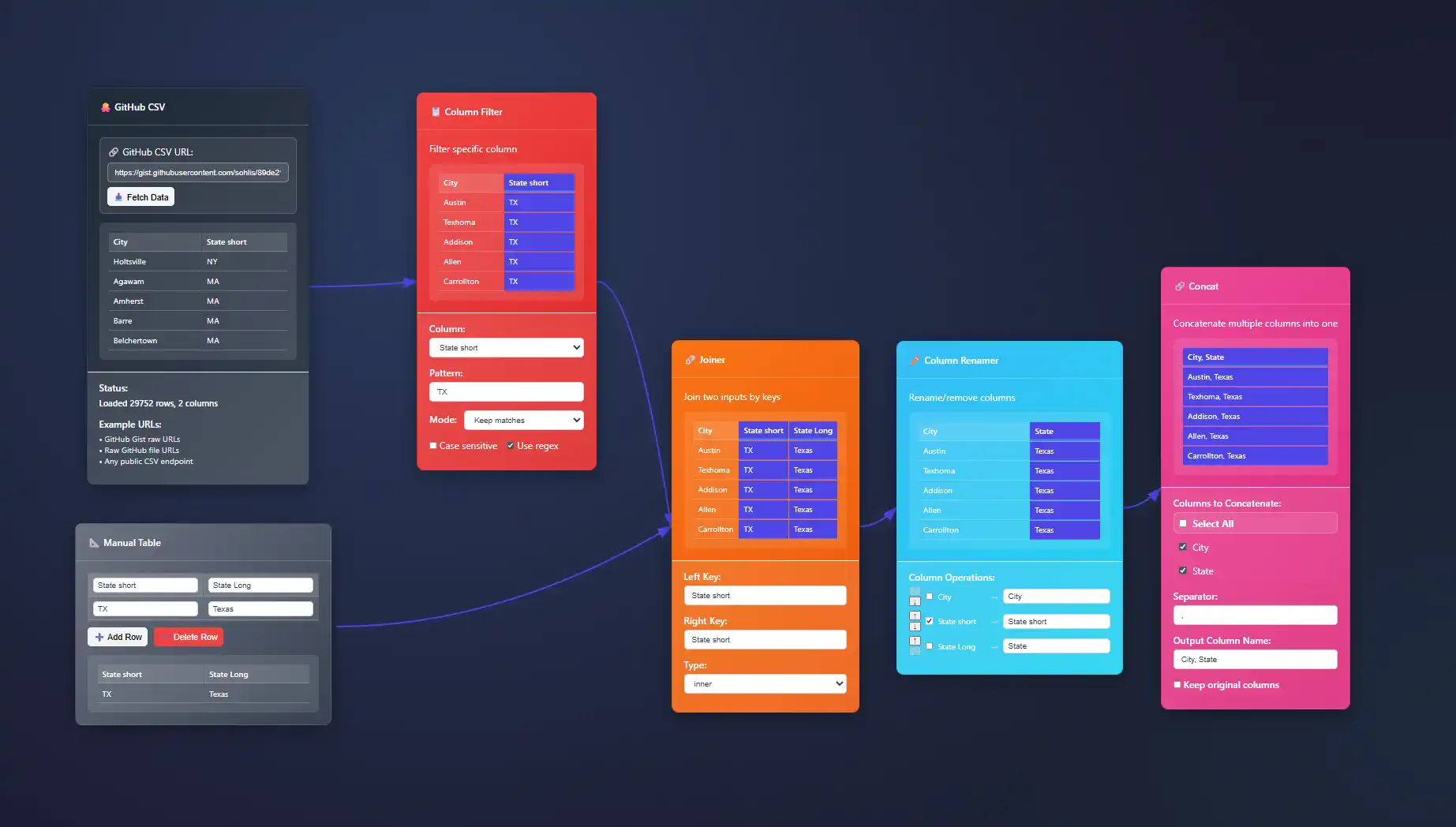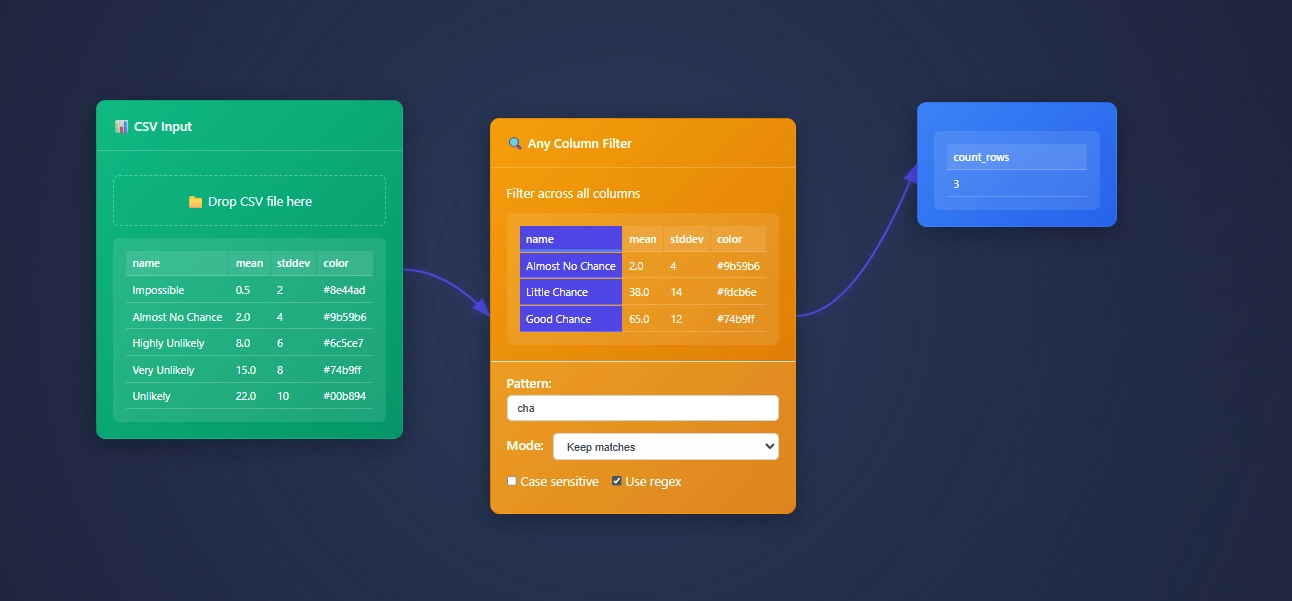
Uncomplicate Data
Create end-to-end data analytics solutions in one app that is simple to use, and self-explanatory.
About ET1
ET1 is a visual data workbench that lets you explore, clean, and explain data solutions.


- Access ET1
- Unlock 24 nodes
- Free ETL software
- Desktop friendly
- Code on GitHub iCore utilities, UI pieces, and node definitions live in the public repository so you can review how processing works.
- No storage
- ET1.1 + GitHub OAuth
- Unlock 29 nodes
- Workflows + Neon LakeiNeon Lake is the persistent store for workflow data and results. The free tier has no storage. This tier includes limited storage and 1 branch.
- 100/CU-monthiCU = Compute Unit. An internal measure we use to track processing cost across transforms.
- 500 MB storageiStorage in Neon Lake for tables and results. Retention policies may apply while we tune usage.
- 1 BranchiThis tier includes a single branch only.
- ET1.1 + GitHub OAuth
- Unlock 29 nodes
- Workflows + Neon Lake
- $0.28/CU-houriMetered compute beyond included quota. Priced per compute-hour equivalent derived from CU usage.
- $0.46/GB-monthiNeon Lake storage billed by logical GB-month. We may introduce archival tiers.
- 3 BranchesiEach branch has isolated CPU and storage. You only pay for the delta (the difference) between branches.
- SOC 2 • HIPAA • GDPR
- Regional locations
- User-level pricing
- $0.52/CU-hour
- $0.49/GB-month
- 10 Branches
- Unlimited databases & tables
Training Documentation
Use the training material to help you understand more about ET1 and how it helps solve data wrangling problems.

ET1 Basic Training
If you need help getting started, begin here.

ET1 Video Training
Learn the basics, the features, and more.
Future Insight
We see the future being focused on adoption, training, and creating Easy Tools for anyone. We are building an emerging technology while also maintaining a creative user experience that is inviting and friendly for all ages.
Inspiration
We are inspired by software, video games, and Sci-Fi movies like The Matrix, Minority Report and Ironman.
Join beta.
Why do you want to access beta?
Keep It Local: Data Locality Principles for Faster Analytics
In the fast-paced arena of data-driven decision-making, organizations can't afford sluggish data analytics that hinder responsiveness and innovation. While computation power and storage scale has exploded, just throwing processing horsepower at your analytics won't...
Exactly-Once vs At-Least-Once: Error Recovery Trade-Offs
In the fast-paced, data-centric business landscape of today, leaders stand at the crossroads of complex decisions affecting systems reliability, efficiency, and data integrity. Understanding how data moves and how it recovers from errors can mean the difference...
The Memory Wall: Working Sets Larger Than RAM
In today's data-driven landscape, performance bottlenecks become painfully obvious, especially when handling datasets larger than system memory. As your analytics workload grows, the gap between the sheer volume of data and the speed at which your hardware can access...
Irregular Intervals: Wrangling Messy Time-Series
Imagine navigating unfamiliar terrain armed with nothing more than a vague map and inconsistent landmarks placed unpredictably along your path. That's precisely how working with messy, irregularly spaced time-series data can feel. Yet—as daunting as irregular...
Circuit Breakers: Designing Fail-Safe Stream Drivers
The rapid evolution of real-time data analytics has ushered in an era where milliseconds matter more than ever. Imagine overseeing streaming analytics for your organization's critical operations, only to watch helplessly as streams falter under unexpected workloads or...
High-Cardinality Categories: Encoding Strategies That Scale
When diving deep into analytical and machine learning projects, organizations inevitably encounter the challenging realm of high-cardinality categorical variables. Whether you're trying to analyze customer data across thousands of regions or categorize products from...
Long-Running Jobs vs JVM GC: A Love-Hate Story
If you work in data-intensive environments, the phrases "long-running job" and "JVM garbage collection" probably stir both admiration and frustration. They're like those pairs of coworkers who, despite occasional tension, can deliver remarkable results when...
Choreography vs Orchestration: Coordinating Complex Workflows
Imagine watching a symphony perform without a conductor—each musician intuitively knowing precisely when to begin playing and seamlessly harmonizing their contribution with the group. Now, picture the same orchestra, this time guided meticulously by a conductor who...
Network Effects: Bandwidth Pitfalls in Distributed Engines
In the hyper-connected landscape of today's data-driven business ecosystem, distributed engines promise scalability, agility, and the power of real-time analytics. Yet, hidden beneath these compelling advantages lies a subtle and often underestimated challenge:...
Features of Today()+1
Available Now()









